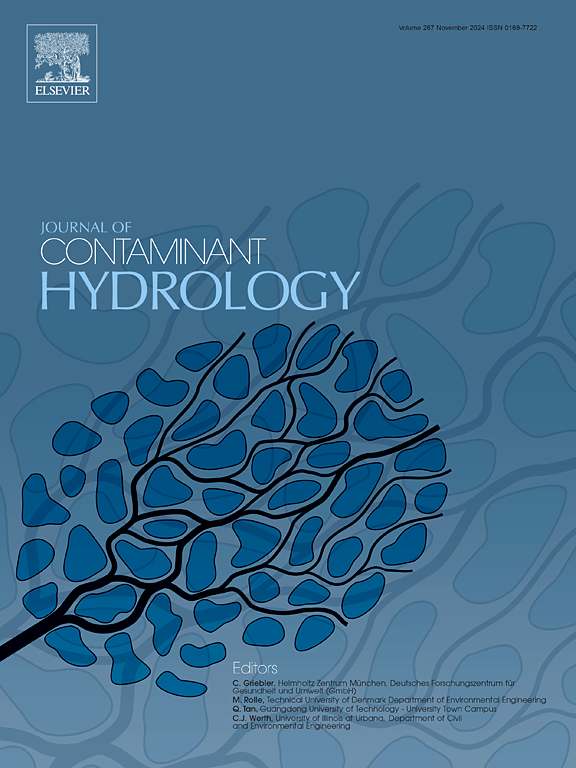Research on the coupled model of fracturing flowback pollution in fractured systems and wellbore of shale gas development under elastic external boundary conditions
IF 4.4
3区 环境科学与生态学
Q2 ENVIRONMENTAL SCIENCES
引用次数: 0
Abstract
To mitigate environmental pollution caused by fracturing flowback fluid, it is essential to quantify the concentration of pollutants within the fluid. This study introduces 3 + 1-dimensional space-time coupled model under elastic external boundary conditions, describing the advection, reaction, and diffusion of pollutants in fracturing flowback fluid within a non-isometric vertical fracture system and wellbore. Then the model is solved to derive expressions for the instantaneous pollutant concentration in vertical fractures and the wellbore. The concentration of pollutants at the wellhead was plotted using MATLAB software. The rationality of the model was verified using actual data. Furthermore, the study investigates the influence of backflow velocities, the lengths of the right and left fracture wings, the horizontal section of the wellbore, and the height of the vertical section on wellhead pollutant concentration. The findings enhance the understanding of the dynamic behavior of pollutants in fracturing flowback fluids at the wellhead, providing valuable insights for environmental management in shale gas development.
弹性外边界条件下压裂返排污染与页岩气开发井筒耦合模型研究
为了减轻压裂返排液对环境的污染,有必要对返排液中污染物的浓度进行量化。引入弹性外边界条件下的3 + 1维时空耦合模型,描述了非等距垂直裂缝体系和井筒内压裂返排液中污染物的平流、反应和扩散过程。然后对模型进行求解,得到垂直裂缝和井筒中瞬时污染物浓度的表达式。利用MATLAB软件绘制了井口污染物浓度图。用实际数据验证了模型的合理性。此外,研究了回流速度、左右裂缝翼长度、井筒水平段和垂直段高度对井口污染物浓度的影响。这一发现增强了人们对井口压裂返排液中污染物动态行为的理解,为页岩气开发中的环境管理提供了有价值的见解。
本文章由计算机程序翻译,如有差异,请以英文原文为准。
求助全文
约1分钟内获得全文
求助全文
来源期刊

Journal of contaminant hydrology
环境科学-地球科学综合
CiteScore
6.80
自引率
2.80%
发文量
129
审稿时长
68 days
期刊介绍:
The Journal of Contaminant Hydrology is an international journal publishing scientific articles pertaining to the contamination of subsurface water resources. Emphasis is placed on investigations of the physical, chemical, and biological processes influencing the behavior and fate of organic and inorganic contaminants in the unsaturated (vadose) and saturated (groundwater) zones, as well as at groundwater-surface water interfaces. The ecological impacts of contaminants transported both from and to aquifers are of interest. Articles on contamination of surface water only, without a link to groundwater, are out of the scope. Broad latitude is allowed in identifying contaminants of interest, and include legacy and emerging pollutants, nutrients, nanoparticles, pathogenic microorganisms (e.g., bacteria, viruses, protozoa), microplastics, and various constituents associated with energy production (e.g., methane, carbon dioxide, hydrogen sulfide).
The journal''s scope embraces a wide range of topics including: experimental investigations of contaminant sorption, diffusion, transformation, volatilization and transport in the surface and subsurface; characterization of soil and aquifer properties only as they influence contaminant behavior; development and testing of mathematical models of contaminant behaviour; innovative techniques for restoration of contaminated sites; development of new tools or techniques for monitoring the extent of soil and groundwater contamination; transformation of contaminants in the hyporheic zone; effects of contaminants traversing the hyporheic zone on surface water and groundwater ecosystems; subsurface carbon sequestration and/or turnover; and migration of fluids associated with energy production into groundwater.
 求助内容:
求助内容: 应助结果提醒方式:
应助结果提醒方式:


